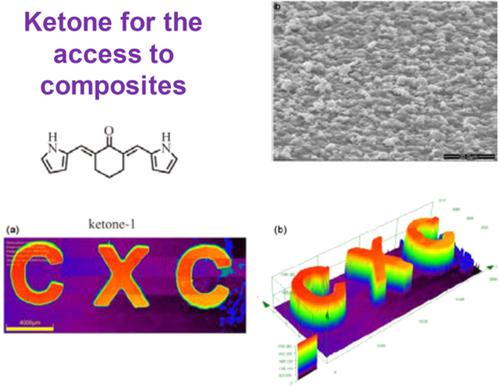当前位置:
X-MOL 学术
›
J. Polym. Sci.
›
论文详情
Our official English website, www.x-mol.net, welcomes your
feedback! (Note: you will need to create a separate account there.)
Design of ketone derivatives as highly efficient photoinitiators for free radical and cationic photopolymerizations and application in 3D printing of composites
Journal of Polymer Science ( IF 3.9 ) Pub Date : 2020-11-05 , DOI: 10.1002/pol.20200658 Yangyang Xu 1, 2, 3 , Zhaofu Ding 1 , Haibin Zhu 1 , Bernadette Graff 2, 3 , Stephan Knopf 2, 3 , Pu Xiao 4 , Frédéric Dumur 5 , Jacques Lalevée 2, 3
Journal of Polymer Science ( IF 3.9 ) Pub Date : 2020-11-05 , DOI: 10.1002/pol.20200658 Yangyang Xu 1, 2, 3 , Zhaofu Ding 1 , Haibin Zhu 1 , Bernadette Graff 2, 3 , Stephan Knopf 2, 3 , Pu Xiao 4 , Frédéric Dumur 5 , Jacques Lalevée 2, 3
Affiliation

|
Herein, thirteen ketone derivatives composed of different cyclohexanone cores and peripheral moieties are designed, among which 10 ketones have never been synthesized before. These ketones are proposed as high‐performance photoinitiators for both free radical polymerizations and cationic polymerizations under soft conditions (visible LED@405 nm irradiation at room temperature). In combination with an amine and an iodonium salt (Iod), these ketones could be used in three−component photoinitiating systems to initiate the free radical polymerization of acrylates with distinct final conversions, among which the ketone−1/amine/Iod combination proved to be the most efficient one. Besides, the ketone−1/Iod two−component system also showed a remarkable photoinitiation ability for the cationic polymerization of epoxides. The photochemical sensitivity of ketone−1 in the presence of an amine and an iodonium salt was systematically investigated by steady state photolysis and excited state fluorescence quenching characterizations, respectively. Interestingly, macroscopic 3D patterns with excellent spatial resolution could be generated using the ketone−1/amine/Iod photoinitiating system for the free radical polymerization of acrylates. This high performance is also found useful to overcome the light penetration issue for the access to filled samples (silica) and the preparation of composites.
中文翻译:

酮衍生物作为自由基和阳离子光聚合的高效光引发剂的设计及其在复合材料的3D打印中的应用
在此,设计了由不同的环己酮核和外围部分组成的十三种酮衍生物,其中从未合成过十种酮。这些酮被认为是在软条件下(室温下可见光@ 405 nm照射下)可用于自由基聚合和阳离子聚合的高性能光引发剂。这些酮与胺和碘鎓盐(Iod)结合使用,可用于三组分光引发体系中,以最终转化率明显的方式引发丙烯酸酯的自由基聚合反应,其中酮/ 1 /胺/碘的组合被证明可以成为最有效率的人。此外,酮1 /碘二组分体系还表现出了显着的光引发能力,可用于环氧化物的阳离子聚合。分别通过稳态光解和激发态荧光猝灭特性,系统地研究了在胺和碘鎓盐存在下酮-1的光化学敏感性。有趣的是,使用酮/ 1 /胺/碘光引发体系用于丙烯酸酯的自由基聚合可以生成具有出色空间分辨率的宏观3D模式。还发现这种高性能有助于克服光穿透问题,从而可以获取填充样品(二氧化硅)和制备复合材料。使用酮/ 1 /胺/碘的光引发体系用于丙烯酸酯的自由基聚合,可以生成具有出色空间分辨率的宏观3D模式。还发现这种高性能有助于克服光穿透问题,从而可以获取填充样品(二氧化硅)和制备复合材料。使用酮/ 1 /胺/碘的光引发体系用于丙烯酸酯的自由基聚合,可以生成具有出色空间分辨率的宏观3D模式。还发现这种高性能有助于克服光穿透问题,从而可以获取填充样品(二氧化硅)和制备复合材料。
更新日期:2020-12-15
中文翻译:

酮衍生物作为自由基和阳离子光聚合的高效光引发剂的设计及其在复合材料的3D打印中的应用
在此,设计了由不同的环己酮核和外围部分组成的十三种酮衍生物,其中从未合成过十种酮。这些酮被认为是在软条件下(室温下可见光@ 405 nm照射下)可用于自由基聚合和阳离子聚合的高性能光引发剂。这些酮与胺和碘鎓盐(Iod)结合使用,可用于三组分光引发体系中,以最终转化率明显的方式引发丙烯酸酯的自由基聚合反应,其中酮/ 1 /胺/碘的组合被证明可以成为最有效率的人。此外,酮1 /碘二组分体系还表现出了显着的光引发能力,可用于环氧化物的阳离子聚合。分别通过稳态光解和激发态荧光猝灭特性,系统地研究了在胺和碘鎓盐存在下酮-1的光化学敏感性。有趣的是,使用酮/ 1 /胺/碘光引发体系用于丙烯酸酯的自由基聚合可以生成具有出色空间分辨率的宏观3D模式。还发现这种高性能有助于克服光穿透问题,从而可以获取填充样品(二氧化硅)和制备复合材料。使用酮/ 1 /胺/碘的光引发体系用于丙烯酸酯的自由基聚合,可以生成具有出色空间分辨率的宏观3D模式。还发现这种高性能有助于克服光穿透问题,从而可以获取填充样品(二氧化硅)和制备复合材料。使用酮/ 1 /胺/碘的光引发体系用于丙烯酸酯的自由基聚合,可以生成具有出色空间分辨率的宏观3D模式。还发现这种高性能有助于克服光穿透问题,从而可以获取填充样品(二氧化硅)和制备复合材料。











































 京公网安备 11010802027423号
京公网安备 11010802027423号